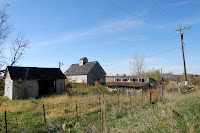
Some two decades later, the town of Fort Madison Iowa
With its location right on the Mississippi River , the city also grew as a manufacturing c enter. Today, its downtown district displays a collection of well-preserved historic storefronts from the late 19th century.
 We then cross the 1927
We then cross the 1927 Continuing along the Great River Road, we stop at historic Navuoo, Illinois, which was established in 1832 and first called Venus. Two years later the name was changed to Commerce and in 1839, when the Mormons bought the entire town site, it was renamed Navuoo. Having been expelled from
 Heading south, our next stop is Warsaw, Illinois, a very interesting little town situated right on the Mississippi River. We first stop at the old Warsaw Brewery, which today services as a bar, restaurant and convention center. Continuing on into town, we find an array of old and new, shabby and chic, and restored and crumbling buildings. Like other river cities,
Heading south, our next stop is Warsaw, Illinois, a very interesting little town situated right on the Mississippi River. We first stop at the old Warsaw Brewery, which today services as a bar, restaurant and convention center. Continuing on into town, we find an array of old and new, shabby and chic, and restored and crumbling buildings. Like other river cities, 
The Hill-Dodge Bank, established in 1864, is still open for business, but down the street, the Farmers Bank is long closed. A few restaurants and bars continue to welcome visitors, as well as a few small businesses, but, overwhelmingly, the fading peeling doors of this once prosperous city have been shuttered for years. Though paint is falling to the ground, windows are broken, and a couple of the buildings have fallen in on themselves, the town is filled with beautiful homes that are well maintained. Warsaw is still populated by about 1,800 people and has several thriving churches; but it appears for shopping, they probably go elsewhere. We visit the site of old Fort Edwards Mississippi River , before moving on down the road.
 Crossing the river once again, our last stop of the day is
Crossing the river once again, our last stop of the day is Hannibal was founded in 1819 but grew slowly during its first several decades. However, when the Hannibal and St. Joseph Railroad was organized in 1846, it became Missouri
Here also, the tourist part of our trip official ends as it is early afternoon and we are homesick. Taking the fastest route, we travel the next 200 miles back 'lil ole Warsaw, Missouri.
Hope you enjoyed the ride and stay tuned as we write up these many places and people onLegends of America.
You can also see more pictures and information on the places we visited on our Facebook Fanpage HERE.



















